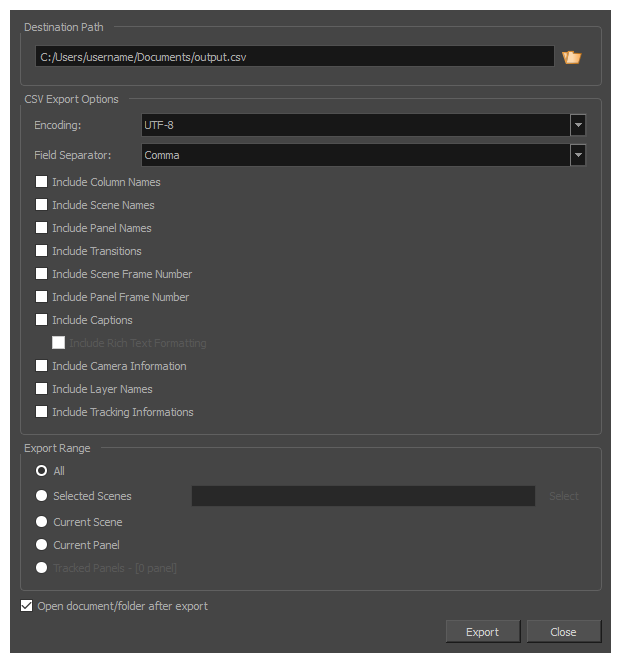The Export CSV dialog allows you to export your project's metadata, such as its scene and panel names, its transitions, the captions for each of your project's panels, the names of each layers in your panels, and other such information into a Comma Separated Value (.csv) spreadsheet.

CSV is a text-based spreadsheet format that is commonly supported by spreadsheet editors, and which is easy to process in scripts and other software as it is merely a text file containing the value of each cell, typically separated by a comma. However, it does not support advanced spreadsheet features such as text formatting and formulas.
Exporting a CSV file can be useful if you wish to view the metadata for your project in a spreadsheet editor, such as Microsoft Excel, LibreOffice Calc or Google Sheets, for analysis, or if you wish to make a script that will use the metadata for your project in any specific way.
You can also use this dialog to export your project's captions into a spreadsheet, edit them in a spreadsheet editor, then import the edited spreadsheet back into your project to update its captions.
A CSV file exported by Storyboard Pro will contain one row for each exported panel. It will also have at least one column, the Object Id column, which stores a special identifier composed of 16 hexadecimal characters for each panel in your storyboard, making sure that Storyboard Pro can identify which row belongs to which panel in your project. Besides the identifier, you can select which type of data gets exported for each panel.
- Select File > Export CSV.
| Parameter | Description |
|
Destination Path |
Lets you specify the location and name of the folder for the storyboard project data. |
|
CSV Export Options |
|
|
Encoding |
Allows you select the text encoding for the CSV file. By default, this option is set to UTF-8. |
|
Field Separator |
Allows you select the character used to separate each cell in the CSV file, among the following options: Comma, Semicolon, Tab or Vertical bar (pipe). By default, this option is set to Comma, and it is the most commonly used field separator among all software that support CSV files. |
|
Include Column Names |
Adds an extra header row at the top which indicates the purpose of each column in the table. |
|
Include Sequence Names |
Adds a Sequence column which indicates the number of the sequence for each panel. |
|
Include Scene Names |
Adds a Scene column which indicates the number or name of each scene for each panel. |
|
Include Panel Names |
Adds a Panel column which indicates the number or name of each panel. |
|
Include Transitions |
Adds a column for each transition in the project, between the rows corresponding to the two panels that are joined by the transition. |
|
Include Scene Frame Number |
Adds a column that indicates the length of the scene in frames. |
|
Include Panel Frame Number |
Adds a column that indicates the length of the panel in frames. |
|
Include Captions |
Adds a column for each caption type in your project, and which will indicate the content of each caption type for each panel. |
|
Include Rich Text Formatting |
If your captions have any formatting, check this option to export the content of your captions in HTML, which will preserve the formatting of your captions. If this option is unchecked, your captions will be exported in plain text. They will be easier to read and edit, but if you re-import the .csv file into your project, the formatting of the captions will be lost. |
|
Include Camera Information |
Indicates whether the camera is static or dynamic (animated) for each panel. |
|
Include Layer Names |
This will add as many columns as the amount of layers in the panel that has the most layers. For each panel, the name of each layer in the panel will be indicated. Layers at the bottom are listed in the leftmost layer column, and layers at the top are listed in the rightmost layer column. |
|
Include Tracking Information |
Indicates whether or not the panel is tracked, the date at which the panel started getting tracked, and the tracking notes added to that panel, if any. |
|
Export Range |
|
|
All |
Exports the entire storyboard. |
|
Selected Scenes |
Select this option to export a specific selection of scenes. Then, click on the Select button to open the Scenes Picker dialog box, in which you can:
|
|
Current Scene |
Exports only the currently selected scene. |
|
Current Panel |
Exports only the currently selected panel. |
|
Tracked Panels - [0 panel] |
Exports panels on which tracking changes is enabled |
|
Open document/folder after export |
Open the exported CSV file in your operating system's default CSV editor immediately after creating it. NOTE Typically, if you installed a spreadsheet editor such as Microsoft Excel or LibreOffice Calc, this will be your operating system's default CSV editor.
|